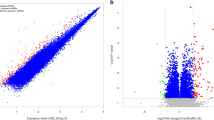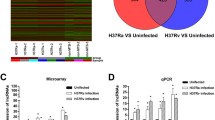Abstract
Tuberculosis (TB) is a fatal infectious disease; however, the molecular mechanisms underlying the pathogenicity of TB remain elusive. The present study aims to identify potential biomarkers associated with Mycobacterium tuberculosis (M.tb) infection by using integrated bioinformatics and in vitro validation studies. GSE50050, GSE78706, and GSE108844 data from the gene expression omnibus (GEO) database were downloaded to identify differentially expressed genes (DEGs). The functions of DEGs were further subjected to gene ontology (GO) and KEGG pathway analysis. The hub genes from the DEGs were determined based on the protein–protein interaction (PPI) network analysis. Finally, the hub genes were experimentally validated using the in vitro functional studies. A total of 26 common DEGs were identified among GSE50050, GSE78706, and GSE108844. The functional enrichment analysis showed that the common DEGs were associated with cytokines response and TB pathways. The PPI network analysis identified nine hub genes. Further in vitro studies showed that nitric oxide synthase 2 (NOS2) was up-regulated in RAW264.7 cells upon lipopolysaccharides (LPS) stimulation, which was accompanied by increased inflammatory cytokines release. Furthermore, NOS2 was found to be a target of miR-493-5p, which was confirmed by luciferase reporter assay. NOS2 was repressed by miR-493-5p overexpression and was up-regulated after miR-493-5p inhibition in RAW264.7 cells. The rescue experiments showed that LPS-induced increase in the inflammatory cytokines of the RAW264.7 cells was significantly attenuated by NOS2 knockdown and miR-493-5p overexpression. Collectively, our results for the first time demonstrated that NOS2/miR-493-5p signaling pathway may potentially involve in the inflammatory response during bacterial infection such as M. tb infection.







Similar content being viewed by others
Data Availability
The authors declare that all relevant data that support the findings of this study are available within the article. Additional data are available from the corresponding author upon reasonable request.
References
Alffenaar JW, Märtson AG, Heysell SK, Cho JG, Patanwala A, Burch G, Kim HY, Sturkenboom MGG, Byrne A, Marriott D, Sandaradura I, Tiberi S, Sintchencko V, Srivastava S, Peloquin CA (2021) Therapeutic drug monitoring in non-tuberculosis mycobacteria infections. Clin Pharmacokinet. https://doi.org/10.1007/s40262-021-01000-6
Allué-Guardia A, García JI, Torrelles JB (2021) Evolution of drug-resistant Mycobacterium tuberculosis strains and their adaptation to the human lung environment. Front Microbiol 12:612675
Biadglegne F, König B, Rodloff AC, Dorhoi A, Sack U (2021) Composition and clinical significance of exosomes in tuberculosis: a systematic literature review. J Clin Med. https://doi.org/10.3390/jcm10010145
Bolajoko EB, Arinola OG, Odaibo GN, Maiga M (2020) Plasma levels of tumor necrosis factor-alpha, interferon-gamma, inducible nitric oxide synthase, and 3-nitrotyrosine in drug-resistant and drug-sensitive pulmonary tuberculosis patients, Ibadan, Nigeria. Int J Mycobacteriol 9:185–189
Chen EY, Tan CM, Kou Y, Duan Q, Wang Z, Meirelles GV, Clark NR, Ma’ayan A (2013) Enrichr: interactive and collaborative HTML5 gene list enrichment analysis tool. BMC Bioinform 14:128
Choi K, Ratner N (2019) iGEAK: an interactive gene expression analysis kit for seamless workflow using the R/shiny platform. BMC Genomics 20:177
Civello AN, Spiropoulos J, Sánchez-Cordón PJ, Hicks DJ, Hogarth PJ, Birch C, Núñez A (2020) The effect of BCG vaccination on macrophage phenotype in a mouse model of intranasal Mycobacterium bovis challenge. Vaccine 38:4755–4761
Costa DL, Amaral EP, Namasivayam S, Mittereder LR, Fisher L, Bonfim CC, Sardinha-Silva A, Thompson RW, Hieny SE, Andrade BB, Sher A (2021) Heme oxygenase-1 inhibition promotes IFNγ- and NOS2-mediated control of Mycobacterium tuberculosis infection. Mucosal Immunol 14:253–266
Cui F, Luo P, Bai Y, Meng J (2021) Silencing of long non-coding RNA FGD5-AS1 Inhibits the progression of non-small cell lung cancer by regulating the miR-493-5p/DDX5 Axis. Technol Cancer Res Treat 20:1533033821990007
Gengenbacher M, Duque-Correa MA, Kaiser P, Schuerer S, Lazar D, Zedler U, Reece ST, Nayyar A, Cole ST, Makarov V, Barry Iii CE, Dartois V, Kaufmann SHE (2017) NOS2-deficient mice with hypoxic necrotizing lung lesions predict outcomes of tuberculosis chemotherapy in humans. Sci Rep 7:8853
Grzelak EM, Choules MP, Gao W, Cai G, Wan B, Wang Y, McAlpine JB, Cheng J, Jin Y, Lee H, Suh JW, Pauli GF, Franzblau SG, Jaki BU, Cho S (2019) Strategies in anti-Mycobacterium tuberculosis drug discovery based on phenotypic screening. J Antibiot 72:719–728
Gutiérrez-González LH, Juárez E, Carranza C, Carreto-Binaghi LE, Alejandre A, Cabello-Gutiérrrez C, Gonzalez Y (2021) Immunological aspects of diagnosis and management of childhood tuberculosis. Infect Drug Resist 14:929–946
Huang L, Nazarova EV, Tan S, Liu Y, Russell DG (2018) Growth of Mycobacterium tuberculosis in vivo segregates with host macrophage metabolism and ontogeny. J Exp Med 215:1135–1152
Huang C, Wang Q, Ma S, Sun Y, Vadamootoo AS, Jin C (2019) A four serum-miRNA panel serves as a potential diagnostic biomarker of osteosarcoma. Int J Clin Oncol 24:976–982
Le Y, Cao W, Zhou L, Fan X, Liu Q, Liu F, Gai X, Chang C, Xiong J, Rao Y, Li A, Xu W, Liu B, Wang T, Wang B, Sun Y (2020) Infection of Mycobacterium tuberculosis promotes both M1/M2 polarization and MMP production in cigarette smoke-exposed macrophages. Front Immunol 11:1902
Leisching G, Pietersen RD, van Heerden C, van Helden P, Wiid I, Baker B (2017) RNAseq reveals hypervirulence-specific host responses to M. tuberculosis infection. Virulence 8:848–858
Liu H, Xiong X, Zhu T, Zhu Y, Peng Y, Zhu X, Wang J, Chen H, Chen Y, Guo A (2020) Differential nitric oxide induced by Mycobacterium bovis and BCG leading to dendritic cells apoptosis in a caspase dependent manner. Microb Pathog 149:104303
Mahi NA, Najafabadi MF, Pilarczyk M, Kouril M, Medvedovic M (2019) GREIN: an interactive web platform for re-analyzing GEO RNA-seq data. Sci Rep 9:7580
Meng QL, Liu F, Yang XY, Liu XM, Zhang X, Zhang C, Zhang ZD (2014) Identification of latent tuberculosis infection-related microRNAs in human U937 macrophages expressing Mycobacterium tuberculosis Hsp16.3. BMC Microbiol 14:37
Mikušová K, Ekins S (2017) Learning from the past for TB drug discovery in the future. Drug Discov Today 22:534–545
Odia T, Malherbe ST, Meier S, Maasdorp E, Kleynhans L, du Plessis N, Loxton AG, Zak DE, Thompson E, Duffy FJ, Kuivaniemi H, Ronacher K, Winter J, Walzl G, Tromp G (2020) The peripheral blood transcriptome is correlated with PET measures of lung inflammation during successful tuberculosis treatment. Front Immunol 11:596173
Pahari S, Khan N, Aqdas M, Negi S, Kaur J, Agrewala JN (2016) Infergen Stimulated macrophages restrict Mycobacterium tuberculosis growth by autophagy and release of nitric oxide. Sci Rep 6:39492
Rath P, Huang C, Wang T, Wang T, Li H, Prados-Rosales R, Elemento O, Casadevall A, Nathan CF (2013) Genetic regulation of vesiculogenesis and immunomodulation in Mycobacterium tuberculosis. Proc Natl Acad Sci USA 110:E4790–E4797
Rodrigues TS, Alvarez ARP, Gembre AF, Forni M, de Melo BMS, Alves Filho JCF, Câmara NOS, Bonato VLD (2020) Mycobacterium tuberculosis-infected alveolar epithelial cells modulate dendritic cell function through the HIF-1α-NOS2 axis. J Leukoc Biol 108:1225–1238
Scanga CA, Mohan VP, Tanaka K, Alland D, Flynn JL, Chan J (2001) The inducible nitric oxide synthase locus confers protection against aerogenic challenge of both clinical and laboratory strains of Mycobacterium tuberculosis in mice. Infect Immun 69:7711–7717
Scriba TJ, Netea MG, Ginsberg AM (2020) Key recent advances in TB vaccine development and understanding of protective immune responses against Mycobacterium tuberculosis. Semin Immunol 50:101431
Seki M, Choi H, Kim K, Whang J, Sung J, Mitarai S (2021) Tuberculosis: a persistent unpleasant neighbour of humans. J Infect Public Health 14:508–513
Shen J, Shi S, Lai Z (2018) Identification of HLA-DQA1 as a susceptibility gene for spinal tuberculosis by exome sequencing. Med Sci Monit 24:3442–3449
Szklarczyk D, Gable AL, Lyon D, Junge A, Wyder S, Huerta-Cepas J, Simonovic M, Doncheva NT, Morris JH, Bork P, Jensen LJ, Mering CV (2019) STRING v11: protein-protein association networks with increased coverage, supporting functional discovery in genome-wide experimental datasets. Nucleic Acids Res 47:D607-d613
Tu H, Yang S, Jiang T, Wei L, Shi L, Liu C, Wang C, Huang H, Hu Y, Chen Z, Chen J, Li Z, Li J (2019) Elevated pulmonary tuberculosis biomarker miR-423-5p plays critical role in the occurrence of active TB by inhibiting autophagosome-lysosome fusion. Emerg Microbes Infect 8:448–460
Van den Bossche A, Varet H, Sury A, Sismeiro O, Legendre R, Coppee JY, Mathys V, Ceyssens PJ (2019) Transcriptional profiling of a laboratory and clinical Mycobacterium tuberculosis strain suggests respiratory poisoning upon exposure to delamanid. Tuberculosis (edinb) 117:18–23
Yang C, Dai Y, Pang S, Guo X (2020) Efficacy of abiraterone combined with flutamide on prostate cancer patients and its effect on serum miR-493-5p and miR-195-5p. Oncol Lett 20:1922–1930
Yasukawa K, Liew LC, Hagiwara K, Hironaka-Mitsuhashi A, Qin XY, Furutani Y, Tanaka Y, Nakagama H, Kojima S, Kato T, Ochiya T, Gailhouste L (2020) MicroRNA-493-5p-mediated repression of the MYCN oncogene inhibits hepatic cancer cell growth and invasion. Cancer Sci 111:869–880
Zhang Q, Sun J, Fu Y, He W, Li Y, Tan H, Xu H, Jiang X (2020) Guttiferone K exerts the anti-inflammatory effect on Mycobacterium Tuberculosis- (H37Ra-) infected macrophages by targeting the TLR/IRAK-1 mediated Akt and NF-κB pathway. Mediators Inflamm. https://doi.org/10.1155/2020/8528901
Funding
None.
Author information
Authors and Affiliations
Contributions
XL and NP designed the experiments and conceived the study; XL, YY, and NL performed the experiments; FL and RF performed the statistical analysis; all the authors approved the manuscript for publication.
Corresponding author
Ethics declarations
Conflict of interest
None.
Ethical Approval
Not applicable.
Consent to Participation
Not applicable.
Consent to Publications
All the authors approved for the submission.
Additional information
Publisher's Note
Springer Nature remains neutral with regard to jurisdictional claims in published maps and institutional affiliations.
Supplementary Information
Below is the link to the electronic supplementary material.
10528_2022_10297_MOESM1_ESM.tif
Supplementary file1 (Functional enrichment analysis of DEGs. A-C The genes were divided into three categories: biological process (A), molecular function (B), and cellular component (C). D The genes were enriched in different KEGG pathways.)
10528_2022_10297_MOESM2_ESM.tif
Supplementary file2 (Effects of miR-493-5p overexpression/inhibition on the NOS2 expression in RAW264.7 cells treated with LPS. A The RAW264.7 cells were treated with miR-493-5p inhibitors for 24 h and were followed by 100 ng/ml LPS for 24 h, the mRNA expression level of NOS2 was determined by qRT-PCR. (B) (A) The RAW264.7 cells were treated with miR-493-5p mimics for 24 h and were followed by 100 ng/ml LPS for 24 h, the mRNA expression level of NOS2 was determined by qRT-PCR. N = 3. Significant differences between groups were illustrated as *P<0.05.)
10528_2022_10297_MOESM3_ESM.tif
Supplementary file3 (Effects of miR-493-5p overexpression or inhibition on inflammatory responses in RAW264.7 cells. (A–F) The RAW264.7 cells were treated with miR-493-5p mimics, miR-493-5p inhibitors, mimics NC or inhibitors NC for 24 h, the mRNA expression levels of IL-1β (A), IL-6 (B), and TNF-α (C) were determined by qPCR; the protein expression levels of IL-1β (D), IL-6 (E), and TNF-α (F) were determined by ELISA assay. N = 3. Significant differences between groups were illustrated as *P<0.05 and **P<0.01.)
Rights and permissions
Springer Nature or its licensor (e.g. a society or other partner) holds exclusive rights to this article under a publishing agreement with the author(s) or other rightsholder(s); author self-archiving of the accepted manuscript version of this article is solely governed by the terms of such publishing agreement and applicable law.
About this article
Cite this article
Li, X., Yang, Y., Lu, N. et al. NOS2/miR-493-5p Signaling Regulates in the LPS-Induced Inflammatory Response in the RAW264.7 Cells. Biochem Genet 61, 1097–1112 (2023). https://doi.org/10.1007/s10528-022-10297-2
Received:
Accepted:
Published:
Issue Date:
DOI: https://doi.org/10.1007/s10528-022-10297-2




